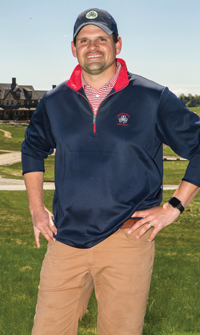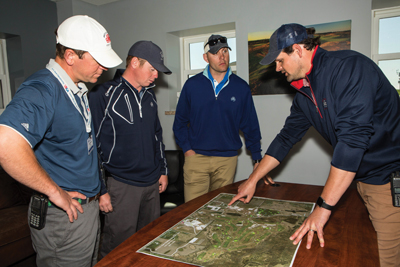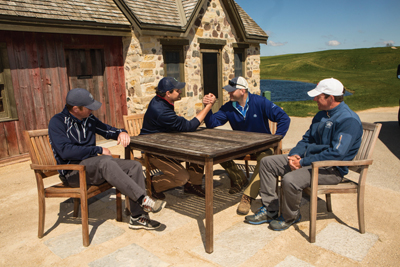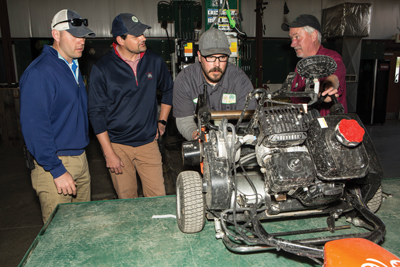From the June 2017 issue of GCM magazine:
State of readiness
Zach Reineking, Wisconsin born and bred, and a team of fellow native sons have Erin Hills primed and ready for one of the biggest events in the state’s golf history: this month’s U.S. Open.

Photo courtesy of Erin Hills
Scott Hollister
Read this story in GCM's digital edition »
In Wisconsin, sport is king. And growing up in Sheboygan Falls, there was no more loyal a subject in that kingdom than Zach Reineking.
Whether it was the Green Bay Packers (famed Lambeau Field is just an hour north of Sheboygan Falls), the football and basketball teams at the University of Wisconsin (of which Reineking is a proud alumnus) or the Brewers and Bucks in Milwaukee, Reineking was raised with a deep affinity for all of them — both the teams themselves and the games they played.
If there were one sport that trumped them all, though — one that drew out of him a little more loyalty than the others — it was golf. He loved to play the game. His childhood home was less than 10 minutes from the then-newly constructed courses at Blackwolf Run. By age 13, he was caddying regularly at nearby Pine Hills Country Club.
“That’s where my passion for the industry and the game of golf all started,” Reineking says. “Just being around all that great golf, working at Pine Hills ... that’s what really hooked me.”

Photo by Hayley McCormick/EPIC Creative
But even someone as passionate about Wisconsin sports (and Wisconsin golf, in particular) as Reineking was couldn’t have predicted the heights to which the game would rise in the Badger State. Since 1998, it has hosted six major championships, all at the Kohler properties of Whistling Straits and Blackwolf Run. And this June, that championship pedigree will get its most notable addition when Erin Hills — with Reineking overseeing preparations as the club’s GCSAA Class A director of course maintenance — welcomes the 2017 U.S. Open, an occasion that 35-year-old Reineking readily admits 13-year-old Reineking would have never dreamt possible.
“Listen, I’m passionate about our state. I was born here. I went to school here. I follow all of the teams here,” the 14-year association member says. “But all of this is something that 12- or 13-year-old me — who couldn’t have loved golf or the state of Wisconsin any more than I did — wouldn’t have been able to imagine.
“When most people think about Wisconsin, they think about the Packers, cheeseheads, Lambeau Field. That the game of golf has started to alter that thought — that it’s made the state a bit of a destination and had the economic impact that it’s had — is pretty incredible.”
The hills are alive
Of course, the true scene-stealer in this story, the Wisconsin original that will attract the bulk of the attention come the second full week of June, is the golf course that Reineking and his team tend to.
Erin Hills will be just 11 years old when the U.S. Open comes to town, making it the second-youngest facility ever to host that championship (Chambers Bay was just a few days shy of its eighth birthday when it hosted the 2015 Open). But in those 11 years, the 652-acre property — only 285 acres of which make up the golf course proper — has done plenty of living.
It’s been a mainstay on the lists of America’s top golf courses since it opened its doors (most recently, it ranked 44th on Golf Digest’s 2017-18 list of America’s 100 greatest golf courses). It’s hosted a pair of significant USGA championships — the 2008 U.S. Women’s Amateur Public Links and the 2011 U.S. Amateur. And it’s undergone game-changing renovations intended to fortify the property for major championship golf while still maintaining the wild, natural flow envisioned by course architects Michael Hurdzan, Ph.D., Dana Fry and Ron Whitten.
And now, the 117th U.S. Open arrives to add another chapter to Erin Hills’ brief but storied history. If you listen to those most invested in the property, there is little doubt that it’s ready for its turn in the spotlight.
“I compare Erin Hills to some of the great U.S. Open sites, like Shinnecock, like Pebble Beach, like Oakmont,” says USGA executive director Mike Davis. “This stands up with all of them.”
Hurdzan, GCSAA’s Old Tom Morris Award winner in 2013, is equally confident that Erin Hills is a deserving host for this month’s championship. “As soon as you see the land,” he said in an interview with the U.S. Open’s official website, www.usopen.com, “you’re just automatically like, ‘God, this is absolutely incredible.’”

Erin Hills superintendent Zach Reineking (right) has relied on a veteran team of senior leaders during the club’s preparations for this month’s U.S. Open, including (from left to right) assistant superintendents Alex Beson-Crone and Alex Ayers, and associate superintendent John Jacques.
Photo by Hayley McCormick/EPIC Creative
Fork in the road
That Reineking is the man to lead preparations for this particular Open seems an open-and-shut case for divine intervention. From his aforementioned fondness for both the state and the game of golf to his professional experience at not just Erin Hills but also Wisconsin’s other well-known championship venues, Reineking appears ready-made for this time and this opportunity.
Alas, it almost didn’t happen this way. An Evans Scholar from his days caddying at Pine Hills, Reineking originally went to the University of Wisconsin to pursue a career in landscape architecture. “I really was drawn to the idea of not just designing something, but then going out and implementing it,” he says.
But after two years in that program, spending way more time at the drafting table than he was in the field, bringing his designs to life, a frustrated Reineking reached a crossroads. One direction would keep him on a path toward a degree in landscape architecture. The other direction ... well, he wasn’t so sure where that one would lead.
Enter Wayne Kussow, Ph.D., the longtime head of Wisconsin’s soil science and turfgrass management programs. Brought together by a friend who was already studying under Kussow, the pair met to discuss Reineking’s options. “We talked about what I was passionate about, what some of my frustrations were with what I was doing,” Reineking says. “And within 45 minutes, he had changed all my classes, got me on a path where I could still graduate in a reasonable amount of time — just set me in a new direction toward a career in golf.”
One of the first duties on that new route, thanks to Kussow’s guidance, was finding an internship in golf course management, a chance to get out in the field and finally start putting some of those lessons he was learning into practice. That opportunity came close to home, at the River Course at Blackwolf Run.
“Within the first two months, I just fell in love with the industry, fell in love with what I was doing,” Reineking says. “I said to myself, ‘This is what I’m going to do for my career. This is my passion, and I’m going to pursue this and stay on this track.’”

The dramatic contours and vistas of Wisconsin’s Kettle Moraine northwest of downtown Milwaukee are home to Erin Hills, co-designed by Michael Hurdzan, Ph.D., Dana Fry and Ron Whitten. Pictured here is the par-3 ninth hole.
Photo © USGA/John Mummert
Climbing the ladder
Reineking’s experiences at Blackwolf Run opened the door to his next internship, at its sister facility Whistling Straits as the team there was preparing for and ultimately playing host to the 2004 PGA Championship. “That just took everything to the next level,” he says. “The golf courses were recently constructed. They were preparing for a major, but they still were constantly going through construction projects, which was exciting to me as well.”
That next spring, with graduation looming, Reineking turned back to Whistling Straits to inquire about full-time work. And although then-superintendent David Swift was receptive to the idea, he suggested Reineking broaden his horizons a bit and look down the road at another project that was just getting off the ground — the construction of Erin Hills.
Former Whistling Straits assistant Jeff Rottier had just been hired as the head superintendent at Erin Hills, and Swift suspected that an assistant position there and the start-to-finish construction experience that would come with it would be just what Reineking needed to round out his golf course management résumé.
Before he knew it, Reineking was in a jeep with Rottier, riding the property that would soon become Erin Hills. “At that point, there was some irrigation that had been pulled, stakes in the ground that showed where teeing grounds were, where landing zones were, where all the greens were going to be,” Reineking says of his first trip around the property. “It was just a raw piece of land.”
Raw, but a piece of land that oozed potential, at least as Reineking saw it. When Rottier extended him an offer to join the team at Erin Hills, he leapt at the opportunity. And as thrilled as he was about it, even Reineking couldn’t have predicted where his time there would take him.

Preparing for a major championship is never a one-man job, and Reineking (second from left) is quick to emphasize how the camaraderie and teamwork among the maintenance team at Erin Hills have helped in the work they’ve done in advance of the U.S. Open. They’re the key “to everything
we’ve done around here,” he says.
Photo by Hayley McCormick/EPIC Creative
Ready for prime time
Now’s a good time to tackle one of golf’s urban legends head-on: No, the USGA did not award Erin Hills a U.S. Open before construction on the course even began. The course opened for play in August 2006, some 14 months after Reineking started there, and the official announcement that the property would host this month’s championship happened in June 2010.
That doesn’t mean original course owner Bob Lang, the architects and those surrounding the project didn’t have high hopes for Erin Hills from the very beginning. “There was definitely some excitement,” Reineking says. “Folks from the USGA had seen the property. There were conversations … just talking about, ‘When we build this, do we build this in a way that is conducive to hosting future tournaments?’”
In most cases, that approach might require extensive planning, significant earthmoving, a more intrusive construction process. At Erin Hills, though, it simply meant accepting what Mother Nature had devised, peeling back the pastures that had been the land’s primary use up until then and revealing the area’s dramatic contours and mounding, which had seemingly been placed there with golf in mind.
From the start, that minimalist approach created plenty of drama, but also some noticeable quirkiness. “There were some blind tee shots, blind approach shots into holes,” Reineking says. “The seventh hole, a par 3, had a blind tee shot, so there was this aiming rock that you aimed at. You couldn’t see the green at all, but if you were at least close to that rock, you would probably be pretty close to the green.”
Following the 2008 U.S. Women’s Amateur Public Links, the USGA suggested the course consider some changes to soften those quirks, and ownership obliged. Bunkers and new teeing grounds were added. Some greens were relocated. A former “extra” 19th hole from the original construction was pulled into service as a part of the course’s regular routing.
But those weren’t the only changes transpiring at Erin Hills. First, there was a change at the top of the maintenance department, as Rottier and the club parted ways (the 19-year GCSAA member is now the Class A superintendent at Janesville [Wis.] Country Club). That left Reineking in charge, suddenly thrust into his first head superintendent position and trying to figure out not only how to manage day-to-day duties on the golf course, but also the construction work that was taking place. “It was all pretty new to me, a lot to figure out,” he says.

The par-5 finishing hole at Erin Hills, with the Basilica
at Holy Hill looming on the horizon.
Photo © USGA/John Mummert
Not long after, Erin Hills also underwent a change in ownership. Lang — who was the visionary and driving force behind the original creation of Erin Hills — had always been extremely supportive of the club’s maintenance team, but the costs of the course changes underway at the time were taking a financial toll. In October 2009, he sold the property to Andy Ziegler, a managing partner and co-founder of investment management firm Artisan Partners.
And if that wasn’t enough, while all of this was going on, Reineking and his wife, Bridget, were preparing for the birth of their first child, due only days after the sale of the course to Ziegler was finalized.
Reineking understood there were no guarantees with a new owner, one who would have new hopes, dreams and expectations for Erin Hills. But the day after the transaction was complete and the day before Bridget gave birth to a daughter, Nola, Reineking met with Ziegler and laid out his assessment of the current state of the course, his vision for where he wanted to take its maintenance and a five-year plan about how he would get it there.
“Honestly, he could have easily come in, worked with the architects, asked, ‘Who do you know that’s a great fit for Erin Hills, a seasoned guy that we can plug in right now?’” Reineking says. “But fortunately for me, we clicked. He liked the skill set I had and thought the plan I presented was appropriate, and on we went.”
Nearly a year later, a renewed and refreshed Erin Hills reopened for play. “It was really a second chance for us to make a first impression,” Reineking says.

Erin Hills equipment manager Tim Roddy (second from right) and assistant equipment manager Alan Knoblauch (far right) have worked closely with Jacques (left) and Reineking (second from left) in their preparations for the U.S. Open.
Photo by Hayley McCormick/EPIC Creative
Closing arguments
For the players competing in this year’s U.S. Open, chances are good that their practice rounds during tournament week will be the first impression they have of Erin Hills. That’s because, in a somewhat unique move, the course has been completely closed to play since early last October.
Reineking says the strategy behind that decision was twofold. “First, it gave us the chance to do some of those aggressive cultural practices, and do them early,” he explains. “Instead of waiting until the very end of the season to do aerification, we aerified greens in the first week of October. We aerified tees. We did all our usual fall practices, but we did them three weeks earlier, which allowed the turf to heal up nicely before we put the course to bed for winter.
“Now, fast-forward to today, and not being open for play in the weeks before the Open has really allowed us to fine-tune things. We can topdress, we can verticut, and we can do those things without having to worry about working around play.”
Having a deep, seasoned maintenance team handling those duties in addition to all the preparations for the Open has also been a boost to Erin Hills. In season, the club boasts a staff of nearly 50 employees, and during the week of the tournament, Reineking expects to have another 120 volunteers at his disposal.
Managing a team of that size won’t rest solely on Reineking’s shoulders, of course. He’s been quick to share duties, both day-to-day and Open-related, with a senior leadership team led by associate superintendent John Jacques, a 10-year GCSAA member, and also featuring assistant superintendents Alex Beson-Crone (a six-year member of GCSAA) and Adam Ayers (a four-year association member), as well as equipment manager Tim Roddy (a three-year member of GCSAA).
“I can’t emphasize enough how important our entire staff has been to everything that we’ve done around here,” Reineking says. “And when it comes to guys like John, Alex, Adam and Tim, I’m really fortunate that those same handful of guys have been with us for the last five or six years. They’ve all made a huge commitment to Erin Hills and to preparing for this U.S. Open.”
That’s something they certainly have in common with the kid from Sheboygan Falls who loved the Packers, the Badgers and the game of golf. Reineking and his team are determined to make this championship a success for both Erin Hills and the state of Wisconsin, and those who’ve worked closely with them in the run-up to championship week have no doubt they’ll pull it off.
“Zach is about as calm a person as I have worked with in this role,” says Darin Bevard, the USGA’s director of championship agronomy. “I think he’s calm because he’s confident in his abilities. I think he feels he’s been planning and preparing for this for a long time, and he knows he has the support of a great team at Erin Hills.”
Scott Hollister is GCM’s editor-in-chief.